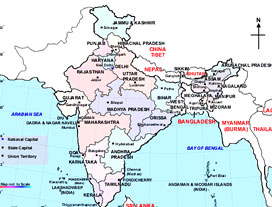| |

Wine has been known and made in India for 2,000 years, but it took the 16th century Portuguese colonists to establish a wine industry with any continuity. Goa's Portuguese varieties are still producing wine, but there is a new wave of tehnically- competent winemaking producing conscious imitations of modern European wines with some success. European grape varieties such Chardonnay, Ugni Blanc, Muscut, Pinot Noir, Merlot and Cabernet Sauvignon are now being planted with increasing seriousness.
India has around 50,000ha (123,500 acres) of vineyards, but less than 1% is used for wine (167,000 cases a year). Production is centred east and north-east of Bombay in the Deccan area, a highland zone with a tolerable, if not ideal, grape-growing climate. Government restrictions used to force entrepreneurs to export all their wine, but in 1988 regulations relaxed to allow 25% of production to be sold at home. A number of Indian wine companies are now linking up with Western investors who can help with export sales, in return gaining entry into India's massive market of 800 million people.
Traditionally, Indian wines are thick, sweet - and sold in screw-cap bottles. But 1985 saw the launch of Omar Khayyam, a "traditional method" sparkling white wine. This award-winner has captured the imagination of the international wine world and, almost single-handedly, it has led India's slowly expanding quality-wine industry towards the 2 1 st century.
|
|
|
|


